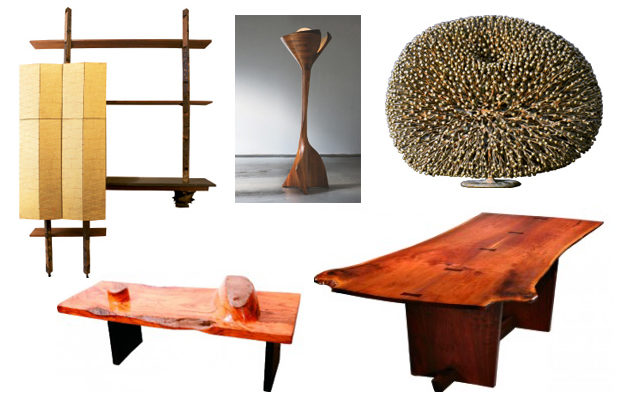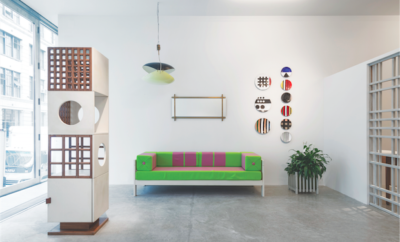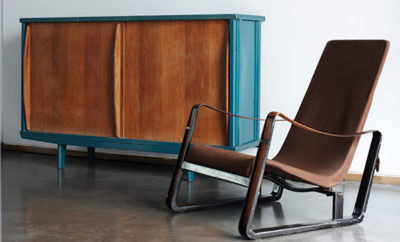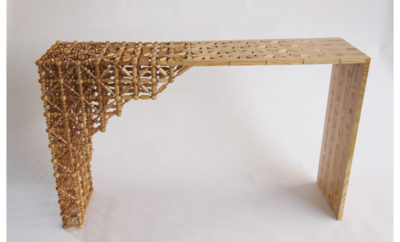
Design
Masters of the Modern Era
Five dealers zero in on Mid-century design giants

This bar cabinet and serving shelf, 1964, is an early collaboration between Evans and Phillip Lloyd Powell. Powell designed the cabinet (in American walnut with gold leaf on the doors) and Evans designed the triangular steel poles decorated with bronze.
American modern masters such as Paul Evans, George Nakashima, Harry Bertoia, Wendell Castle, and others are now soaring in popularity globally. This is in marked contrast to three decades ago, when the studio furniture movement fell into the doldrums. MODERN magazine caught up with five specialty dealers to glean how they view this rapidly maturing market. All are now seeing clients hailing from abroad, demonstrating the widening appeal of this category. The appeal of the modern masters is understandable, says Gerard O’Brien, who heads up Los Angeles’s Reform Gallery. “In this high tech world, studio furniture represents a certain spirit with real staying power.”
Greenwich Village-based dealer Todd Merrill concentrated on this market early and heightened its profile by coauthoring, with Julie Iovine, the influential book Modern Americana: From High Craft to High Glam (2008), highlighting the work of such pivotal figures as Castle, Evans, Nakashima, Wharton Esherick, and Sam Maloof. Top of the heap in terms of sales for Merrill are Paul Evans (1931–1987) and Phillip Lloyd Powell (1919–2008), who collaborated to create their craggy forged furniture. Now prices are, well, stratospheric. In 2006 the large consoles hovered in the $150,000 range. But the Robert Isabell sale at Sotheby’s in December 2009 established a new benchmark for them one scored $218,500. More contemporary art collectors and dealers began snapping up their work. “I sold one for $275,000,” Merrill says.
Certain to fuel the market to even higher heights is an exhibition focusing on the work of Paul Evans that is slated for 2014 at the James A. Michener Museum in Doylestown, Pennsylvania. A retrospective spanning his entire career, it will include examples of his collaborative work with Powell. Merrill is lending a number of examples to the show.
Today, a stunning half of Merrill’s clientele is from outside the United States. He participated this spring in the Collective.1 Design Fair in New York City, at the Pavilion of Art and Design in both Paris and in London, and at Zona Maco: Mexico Arte Contemporáneo; he will also show at the International Fine Art and Antiques Dealers Show, and Design Miami, Gallery Seoul12, and The Salon: Art and Design in New York, all later this year.

Hand-carved and stack-laminated walnut floor lamp designed and made by Wendell Castle, 1970.
For Robert Aibel, who heads up Moderne Gallery, a twenty-thousand-square-foot space in Philadelphia, George Nakashima (1905-1990) and Wharton Esherick (1887-1990) are center stage. “When I began selling Nakashima in 1985, prices were low and his work was treated as used furniture by some,” Aibel says. A decade later, Nakashima became a household name and his work is now included in interiors from modern and contemporary in this country to ones in Asia, Aibel reports. “Famous names usually attached to Nakashima include Steven Spielberg, Tom Hanks, Diana Krall, and the late Steve Jobs,” he adds.
Talk about spectacular growth: Aibel now has clients hailing from beyond Europe to Korea, Qatar, and Brazil. He has sold Esherick to the Museum of Fine Arts, Houston. Interior designers Michael Formica and Alan Wanzenberg are clamoring for examples. At press time, he was offering spectacular ten-foot-long Nakashima Persian walnut, bookmatched Minguren II dining table for $350,000. Two decades ago, prices for Esherick’s quixotic furniture and sculpture slowly started to climb. “But when we staged a major exhibition in our gallery in 1996, it kicked demand into high gear,” Aibel says.An Esherick sculpture can go for $275,000 and a chair for up to $125,000. What is stoking the market? “The growing interest in American studio furniture, and the recognition that Esherick was the father of the movement,” he says.
Aibel takes on a number of prestigious fairs, including the Winter Antiques Show, The Salon: Art and Design, and Design Miami.

George Nakashima
At Tribeca-based R20th Century, headed by Zesty Myers and Evan Snyderman, the work of Wendell Castle (1932–) is especially prominent. Myers and Snyderman began selling Castle’s vintage work back in 2002. The market was not robust then, but today his oeuvre is highly sought, both here and beyond American shores. Their clientele also includes Brits and Koreans.
Castle’s designs blur the boundaries between art and design as well as between form and function. In celebration of his turning eighty last year, Snyderman co-curated with Alyson Baker a major exhibition of vintage works at the Aldrich Contemporary Art Museum in Connecticut. That show, Wendell Castle Wandering Forms— Works from 1959–1979, and the accompanying catalogue were the first in more than twenty years to focus on that part of Castle’s career. Cementing Castle’s renown, his designs can be found in the Museum of Modern Art, the Metropolitan Museum of Art, and the Art Institute of Chicago. Art consultants as well as collectors of contemporary art and design seek his anthropomorphic forms.
Myers and Snyderman regularly participate in Design Miami, Design Miami/ Basel, and Design Days Dubai. This past spring they showed at Collective.1, held during Frieze in New York. “The value of vintage Castle will continue to rise, especially since many collectors are still just now discovering his work,” Myers says.
In Lower Manhattan, Jim Elkind of Lost City Arts is witnessing fierce demand for the work of Harry Bertoia (1915–1978). “While Bertoia is best known for his Diamond chair, he used design as a springboard to his sculpture,” Elkind observes. What’s new for Elkind is an expanding client base. “Second to our U.S. collectors, our next best clients come from Brazil, Argentina, and Peru,” he says. At Sandy Smith’s Salon: Art and Design fair last November, Elkind scored a sale to a Russian oligarch.

Bush sculpture by Harry Bertoia in copper and bronze, c.1960.
“With a lack of confidence in the dollar, more people are viewing modern masters as a rock solid asset,” Elkind says. One sign of the vibrancy of this market is the record price paid last year at Christie’s New York for Bertoia’s 1955 Screen Tree, which soared to $578,500 leaving its $150,000 to $200,000 estimate in the dust. Elkind sold a maquette of the screen sculpture Bertoia designed for the Manufacturer’s Hanover Trust building on Fifth Avenue, for a solid five-figure price to an American client at the Haughtons’ International Fine Art and Antique Dealers Show this past October.(Fans of Bertoia won’t want to miss Harry Bertoia: Structures & Sounds, an exhibition at the Michener Museum from July 20 to October 13.)
Interior designers who favor Elkind’s inventory include Peter Marino, Steven Gambrel, and Shawn Henderson to name just a few. Elkind participates in the prestigious Winter Antiques Show, and this spring he showed at the inaugural Collective.1 Design Fair staged by Steven Learner.
Over on the West Coast, design by such pivotal California furniture stars as Sam Maloof and J. B. Blunk is coveted, according to Gerard O’Brien, whose Reform Gallery draws a Hollywood and international clientele. “Today appreciation for handcrafted design is growing exponentially and in some cases there’s a finite amount available,” he says.
A lot of collectors focus on the work of Maloof, though he hardly falls into the solely regional category. Maloof was the first craftsman to be awarded a MacArthur Foundation Fellowship and his work can be found in the Metropolitan Museum of Art, the Philadelphia Museum of Art, and other museums. The Smithsonian Institution named him “America’s most renowned contemporary furniture craftsman” in 2001. He crafted rocking chairs for Presidents Ronald Reagan, Jimmy Carter and Bill Clinton. Indeed, his rockers are highly sought after and can go for $100,000 depending on the type of wood. “His work is exceedingly rare,” O’Brien notes.
As for J. B. Blunk, three years ago, L.A.’s contemporary art gallery Blum and Poe mounted an exhibition devoted to both his furniture and his sculpture. “That recognition in the art world for what his work is—pure sculpture, including his functional pieces was long overdue,” O’Brien says. Blunk produced only two hundred pieces of furniture, much of it in redwood and cypress. A 1988 Long table in O’Brien’s inventory is tagged at $70,000. He also carries Blunk ceramics and those of Otto and Gertrud Natzler. A Natzler vessel can reach $10,000 and higher.

J.B. Blunk’s long table in carved eucalyptus with black stained redwood supports, 1988-1989.
On O’Brien’s fair roster are the Los Angeles Antiques Art and Design Show, the Palm Springs Modernism show, and NYC 20, hosted by 1stDibs. “These days interior designers, along with both seasoned and novice collectors, are finding that studio furniture is the perfect fit for a range of decors and commissions across the globe,” O’Brien says.












